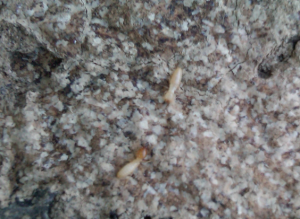Did you know there are an estimated 4000 different species of termites world wide. Different ones have adapted to life in their area of the world and each can pose a real problem due to their different preferences, abilities or places they choose to live. Some live exclusively above ground and need very little moisture while others depend on high moisture content and to get it will build their nest very close to a water supply like boat docks. Fortunately these specialized insects stay for the most part in their neck of the woods but over time their swarms or our commerce can take them to new areas and such is the case with the formosan termite also known as the ‘super termite.’ Be sure to check out the video below of what I found.
Formosans were introduced in America back in 1957 from in Charleston South Carolina. Most likely the termite came along with some goods from southern China where they are originally from. We still get many deliveries of this insect from our ‘buds’ in rail road ties and other goods that we import everyday. Since the 50’s this termite has spread to Texas, New Orleans, Florida, Alabama, Hawaii, Mississippi, Tennessee and the southern most part of California.
Mating flights take place from April to to July in the evenings. Large masses of the winged alates can be seen around street lights or lighting on a home. The formosan shares many of the same attributes as it’s cousin the Eastern Subterranean Termite but major differences do exist. The numbers of formosans can simply dwarf those of other species. Colonies can get into the tens of millions and damage is so often much more devastating. Traditional methods of treating the soil are most times not enough to eradicate the formosan.
Formosans are unique in that they readily live in nests built above ground. True, other subs have been known to do this too but that is more the exception than the rule. Formosans build nests in wall or tree voids and as long as they have sufficient moisture contact with the ground is not always necessary. Their nests are made of a hard ‘carton’ material which is a mixture of saliva, vegetation and chewed wood and this protective material helps keep the colony safe as well.
Standard treatments for formosans almost always include the removal of this nest, treatment of voids, soil treatment and in extreme cases tent fumigation. Damage is so often so much more extreme because of the huge colony size and as their nest grows almost anything in their way is attacked and destroyed. The formosan has been known to chew through materials like pvc, copper, foam insulation boards and plastics but they cannot chew through concrete as popularly believed.
cases tent fumigation. Damage is so often so much more extreme because of the huge colony size and as their nest grows almost anything in their way is attacked and destroyed. The formosan has been known to chew through materials like pvc, copper, foam insulation boards and plastics but they cannot chew through concrete as popularly believed.
The identification of the formosan is crucial since they appear to be just another termite. The best ways are;
Soldiers have oval heads
The amount of soldiers is far more than found in other colonies
Swarms occur in the evenings
Presence of carton
While this termite has not been found in places like Iowa yet, it can be quite the surprise when suddenly your home is being attacked and it’s by some insect you’ve never seen before. This video shows a colony I found in my home town that isn’t really known for this ‘super termite’ and what I had to do to ensure my client was termite free.




